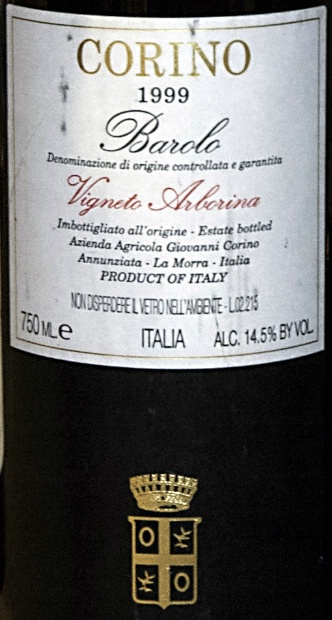
External search
Google (images)
Wine Advocate
Wine Spectator
Burghound
Wine-Searcher
Vintages
2020
2019
2018
2017
2016
2015
2014
2013
2012
2011
2010
2009
2008
2007
2006
2005
2004
2003
2001
2000
Show more
From this producer
Show all wines
All tasting notes
|
| Drinking Windows and Values |
| Community Tasting History |
| Community Tasting Notes (average 89 pts. and median of 90 pts. in 5 notes) - hiding notes with no text | | | Tasted by Eric Guido on 5/5/2013 & rated 90 points: The nose was warming, showing ripe cherry, spiced cookie, undergrowth and herbs with a prominent earthy component balanced well, by hint of wood. On the palate, tart red fruits, dark wood tones and spice with kept fresh by zesty acidity and led to a long satisfying spiced-cherry finish.
**No where did I find the over-oaked, super-modern wine that previous tasting notes suggested. This perfectly stored bottle was decanted and poured back to bottle, to slow-O for six hours. It was a highly enjoyable '99 that is drinking very well now, even in it's youth. (3338 views) | | | Tasted by klezman on 4/6/2013: PnP: Dusty, bottle bouquet, a bit of tar, and surprisingly enough some heat also. Still quite tannic with a lot of earth and spicy nutmeg. Not a ton of fruit, but a touch of rosewater since I'm looking for it. Into the decanter.
With air over the following two hours it opened up a bit but there was no drastic evolution of flavour. The tannins did melt away somewhat, and this went well with lamb rack. (3487 views) | | | Tasted by FLI on 2/1/2013 & rated 92 points: I'm indebted to the previous reviewer TGOOD. This wine is a completely mondovino international style fruit bomb. And, if you like that sort of thing, it's a really good one! I found it very enjoyable, but agree completely that this is not a traditional barolo in any sense. (2876 views) | | | Tasted by Tgood on 1/12/2013 & rated 84 points: I bought a case of this after having an epiphanous moment with an '88 Altare Vigna Arborina - a tightly wound floral minty tannic beast drank in '03 in Napa no less. This wine unfortunately fell victim to so many seeking Parker approval by pushing ripeness to unnatural levels and as a result garnered great reviews in an EWS tasting in NYC prompting my bulk purchase but true to form the wine has been scarcely distinguishable from any asundry of overripe grapes from any other terrior. This wine represents one of the most striking indictments of punditry and group reviews. (2861 views) | | | Tasted by zerhart on 9/25/2008 & rated 90 points: Drinking really well right now but still has plenty of life in it. (4028 views) |
| By Antonio Galloni
Vinous, 1999 Barolo: Brilliance, Intensity and Class (Aug 2014) (11/1/2012)
(Giovanni Corino Barolo Arborina) Subscribe to see review text. | By Antonio Galloni
Vinous, Barolo 1999: The Forgotten Vintage (May 2006)
(Giovanni Corino Barolo Arborina) Subscribe to see review text. | By Stephen Tanzer
Vinous, November/December 2002, IWC Issue #105
(Giovanni Corino Barolo Vigneto Arborina) Subscribe to see review text. |
NOTE: Scores and reviews are the property of Vinous. (manage subscription channels) |
| Giovanni Corino Producer WebsiteNebbioloNebbiolo is a red grape indigenous to the Piedmont region of Italy in the Northwest. The grape can also be found in other parts of the world, though they are not as respected.
Nebbiolo is often considered the "king of red wines," as it is the grape of the famed wines of Barolo DOCG, Barbaresco DOCG, and Roero DOCG. It is known for high tannins and acidity, but with a distinct finesse. When grown on clay, Nebbiolo can be very powerful, tannic, and require long aging periods to reach its full potential. When grown on sand, the grape exhibits a more approachable body with more elegant fruit and less tannins, but still has high aging potential.
"Nebbiolo" is named for the Italian word, "nebbia", which means "fog", in Italian and rightfully so since there is generally a lot of fog in the foothills of Piedmont during harvest.
Nebbiolo is a late-ripening variety that does best in a continental climate that boasts moderate summers and long autumns. In Piedmont, Nebbiolo is normally harvested in October.
More links:
Varietal character (Appellation America) | Nebbiolo on CellarTrackerVigneto Arborina On weinlagen-infoItaly Italian Wines (ItalianMade.com, The Italian Trade Commission) | Italian Wine Guide on the WineDoctorPiedmont Vignaioli Piemontesi (Italian only)
On weinlagen-infoLanghe Consorzio di Tutela Barolo Barbaresco Alba Langhe e Roero | Union of Producers of Albese Wines (Albeisa)BaroloRegional History:
The wines of Piedmont are noted as far back as Pliny's Natural History. Due to geographic and political isolation, Piedmont was without a natural port for most of its history, which made exportation treacherous and expensive. This left the Piedmontese with little incentive to expand production. Sixteenth-century records show a mere 14% of the Bassa Langa under vine -- most of that low-lying and farmed polyculturally. In the nineteenth century the Marchesa Falletti, a frenchwoman by birth, brought eonologist Louis Oudart from Champagne to create the first dry wines in Piemonte. Along with work in experimental vineyards at Castello Grinzane conducted by Camilo Cavour -- later Conte di Cavour, leader of the Risorgimento and first Prime Minister of Italy -- this was the birth of modern wine in the Piedmont. At the heart of the region and her reputation are Alba and the Langhe Hills. This series of weathered outcroppings south of the Tanaro River is of maritime origin and composed mainly of limestone, sand and clay, known as terra bianca. In these soils -located mainly around the towns of Barolo and Barbaresco -- the ancient allobrogica, now Nebbiolo, achieves its renowned fineness and power.
map of Barolo DOCG
An interesting thread on Traditional vs. Modern Barolo producers:
https://www.wineberserkers.com/forum/viewtopic.php?f=1&t=106291 |
|




